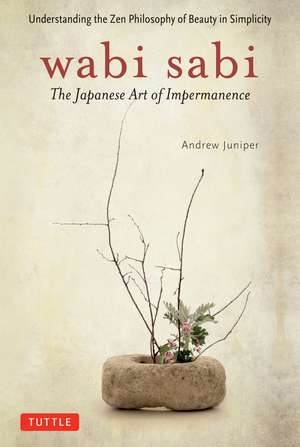Wabi Sabi: The Japanese Art of Impermanence - Understanding the Zen Philosophy of Beauty in Simplicity
Autor Andrew Juniperen Limba Engleză Paperback – 15 noi 2003
Developed out of the aesthetic philosophy of cha-no-yu (the tea ceremony) in fifteenth-century Japan, wabi sabi is an aesthetic that finds beauty in things imperfect, impermanent, and incomplete.
Taken from the Japanese words wabi, which translates to less is more, and sabi, which means attentive melancholy, wabi sabi refers to an awareness of the transient nature of earthly things and a corresponding pleasure in the things that bear the mark of this impermanence. As much a state of mind—an awareness of the things around us and an acceptance of our surroundings—as it is a design style, wabi sabi begs us to appreciate the pure beauty of life—a chipped vase, a quiet rainy day, the impermanence of all things. Presenting itself as an alternative to today's fast-paced, mass-produced, neon-lighted world, wabi sabi reminds us to slow down and take comfort in the natural beauty around us.
In addition to presenting the philosophy of wabi-sabi, this book includes how-to design advice—so that a transformation of body, mind, and home can emerge.
Chapters include:
Taken from the Japanese words wabi, which translates to less is more, and sabi, which means attentive melancholy, wabi sabi refers to an awareness of the transient nature of earthly things and a corresponding pleasure in the things that bear the mark of this impermanence. As much a state of mind—an awareness of the things around us and an acceptance of our surroundings—as it is a design style, wabi sabi begs us to appreciate the pure beauty of life—a chipped vase, a quiet rainy day, the impermanence of all things. Presenting itself as an alternative to today's fast-paced, mass-produced, neon-lighted world, wabi sabi reminds us to slow down and take comfort in the natural beauty around us.
In addition to presenting the philosophy of wabi-sabi, this book includes how-to design advice—so that a transformation of body, mind, and home can emerge.
Chapters include:
- History: The Development of Wabi Sabi
- Culture: Wabi Sabi and the Japanese Character
- Art: Defining Aesthetics
- Design: Creating Expressions with Wabi Sabi Materials
- Spirit: The Universal Spirit of Wabi Sabi
Preț: 59.44 lei
Preț vechi: 70.33 lei
-15% Nou
Puncte Express: 89
Preț estimativ în valută:
11.37€ • 11.92$ • 9.40£
11.37€ • 11.92$ • 9.40£
Carte disponibilă
Livrare economică 22-29 martie
Livrare express 08-14 martie pentru 32.57 lei
Preluare comenzi: 021 569.72.76
Specificații
ISBN-13: 9780804834827
ISBN-10: 0804834822
Pagini: 176
Ilustrații: 25 b&w photos and illus throughout
Dimensiuni: 152 x 229 x 13 mm
Greutate: 0.28 kg
Editura: Tuttle Publishing
Colecția Tuttle Publishing
Locul publicării:United States
ISBN-10: 0804834822
Pagini: 176
Ilustrații: 25 b&w photos and illus throughout
Dimensiuni: 152 x 229 x 13 mm
Greutate: 0.28 kg
Editura: Tuttle Publishing
Colecția Tuttle Publishing
Locul publicării:United States
Recenzii
"A rich read detailing the history, art, culture, design, and spiritual aspects of all things wabi sabi. Explains it deeply and accessibly at the same time." --Chicago Tribune
"For the majority of Japanese, traditional Japanese culture is a lot like fishing. Everyone has fished, but not everyone is a fisherman. Only a few can tell you what every lure, bobber, and fly in a tackle box is. Even less could use them. The fact is, after reading this book, you'll understand both wabi sabi and Zen Buddhism better than 99.99% of the Japanese population." -- Introvert Japan
Notă biografică
Andrew Juniper provides a fascinating explanation of wabi sabi, taking the reader from the art's fifteenth-century Japanese origins to its modern-day practical applications. The book is peppered with photographs and illustrations that demonstrate how wabi sabi can help provide an alternative to the fast-paced, mass-produced, neon-lit world of today. He lives in Sussex, England where he runs the Wabi-Sabi Art Gallery.







